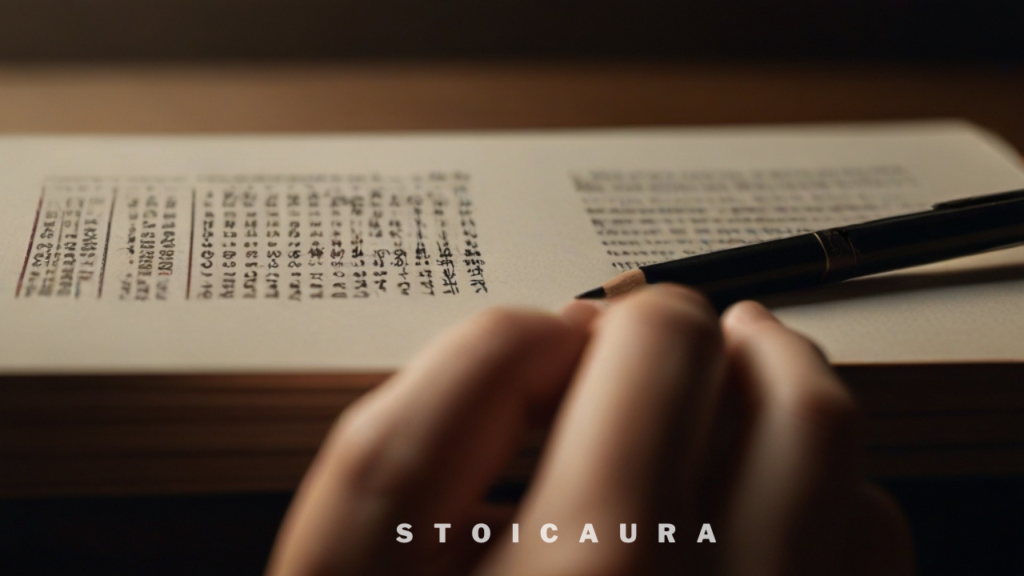Introduction: The Quest for Happiness – A Timeless Pursuit
Okay, let’s be real here. We’re all chasing happiness, right? It’s like this elusive butterfly we keep trying to catch with our self-help books, meditation apps, and endless social media scrolling. But sometimes, it feels like the more we chase it, the further it flies away. Maybe it’s time to take a page from the Stoics, those ancient philosophers who believed happiness comes from focusing on what we can control, not external validation or fleeting pleasures.
I mean, think about it: how often do we get sucked into the comparison trap on Instagram, feeling bummed because someone else’s life seems more “perfect”? What if we channeled that energy into cultivating inner peace and resilience instead? Maybe then, happiness wouldn’t feel like such a distant butterfly, but more like a gentle breeze that’s always there, even when we’re not chasing it.
Humans have been chasing happiness since, well, forever. Philosophers have long debated the best way to snag this elusive butterfly. The Stoics, those chill dudes from Ancient Greece, believed happiness came from focusing on what you can control, like your thoughts and actions, and letting go of what you can’t, like the weather or that annoying neighbor. Basically, don’t sweat the small stuff, and you’ll be way happier. Makes sense, right? But that’s just one approach. Throughout history, countless other thinkers have offered their own two cents on happiness, from seeking pleasure to pursuing knowledge to helping others. So, while there’s no one-size-fits-all answer, it’s clear that happiness has always been a top priority for us curious humans.
Ever heard of Stoicism? It’s an ancient philosophy that’s all about finding inner peace by focusing on what you can control and letting go of what you can’t. Sounds pretty chill, right? But here’s the cool part: modern science is actually catching up to what these guys were saying thousands of years ago! Studies have shown that practicing Stoicism can lead to greater happiness, resilience, and even better decision-making. Turns out, those old Stoics were onto something big. Maybe it’s time we all took a page from their book and embraced a little more Stoic wisdom in our lives.
Okay, so Stoicism sounds pretty cool in theory, but can it actually help us hack happiness in the crazy, chaotic 21st century? After all, we’re dealing with way more stress and distractions than those ancient philosophers ever dreamed of. But here’s the thing: Stoicism isn’t just about lofty ideas, it’s about practical exercises. We’re talking journaling, meditation, and even visualizing worst-case scenarios. And guess what? Research shows these practices can actually work wonders for our mental well-being. So, maybe, just maybe, Stoicism can be the key to unlocking happiness in our modern world. It’s worth a shot, right?

Unveiling the Stoic Toolbox: Techniques for a Flourishing Life
So, what’s Stoicism all about? Basically, it’s a philosophy that helps you live a happier life by focusing on what truly matters. One of their big ideas is virtue ethics, which means striving to be the best person you can be, like being honest, courageous, and just. Stoics also believe in using reason over emotion, so instead of getting swept away by your feelings, you take a step back and think things through.
And finally, they emphasize accepting what you can’t control. You can’t control the weather, the traffic, or what other people think, so why stress about it? By focusing on what you can control and letting go of the rest, Stoicism can be a powerful tool for finding inner peace and happiness.
Want to boost your happiness the Stoic way? Here are some simple practices you can try: First, grab a journal and spend a few minutes each day reflecting on your thoughts and actions. This “Daily Stoic Journaling” helps you stay mindful and live according to your values. Next, try the “Negative Visualization” exercise.
Imagine the worst-case scenario in any situation. Sounds scary, but it actually helps you appreciate what you have and build resilience. Finally, when life throws you a curveball, take a “Stoic Pause.” Before reacting impulsively, take a deep breath and choose a wise response. These practices may seem small, but they can have a big impact on your happiness and overall well-being. Remember, Stoicism is all about taking action, so give these techniques a try and see how they work for you!
Okay, let’s break down those Stoic practices for happiness: First, “Daily Stoic Journaling” is like decluttering your mind. Just like you clean your room to get rid of physical clutter, journaling helps you clear out negative thoughts and emotions, making room for more positive stuff. Next, “Negative Visualization” might sound weird, but it’s actually pretty powerful. Imagine your phone breaks. Annoying, right? But now imagine you never had a phone in the first place. Suddenly, that broken phone doesn’t seem so bad. This practice helps you appreciate what you have and build resilience for when things don’t go your way.
Finally, the “Stoic Pause” is your secret weapon against stress. Before reacting to a frustrating situation, take a moment to breathe and think. This helps you avoid saying or doing something you might regret later. Remember, Stoicism is all about taking control of your emotions and living a meaningful life. Give these practices a try and see how much happier you can be!
From Papyrus Scrolls to Brain Scans: The Science Behind Stoicism
Ever heard of Positive Psychology? It’s like regular psychology, but instead of focusing on what’s wrong with people, it focuses on what makes them thrive. Think of it as the science of happiness! Positive Psychology researchers study things like gratitude, resilience, and meaning in life, all with the goal of helping people live their best lives. Now, this might sound a bit different from Stoicism, which emphasizes accepting what you can’t control. But both approaches actually share a common goal: helping us live happier, more fulfilling lives. So, whether you’re drawn to ancient wisdom or modern science, there are plenty of tools and techniques out there to help you boost your well-being.
It’s pretty cool how ancient Stoicism and modern psychology are starting to see eye-to-eye on what brings happiness. Take journaling, for example. Stoics have been doing it for centuries, and now it’s a cornerstone of mindfulness practices. Both approaches encourage us to become aware of our thoughts and feelings without judgment. This self-awareness helps us manage our emotions and make better choices. Another example is cognitive reframing, which is basically changing the way you think about a situation. Stoics were masters at this, reminding themselves that challenges are opportunities for growth. So, while the language might be different, both Stoicism and modern psychology offer practical tools for living a happier, more fulfilling life.
Remember the Stoic Pause? Turns out, science is totally on board with this technique. Studies have shown that taking a moment to pause and reflect before reacting can lead to better emotional regulation, which basically means being able to manage your emotions in a healthy way. This is a big deal because good emotional regulation is linked to all sorts of good stuff, like increased happiness, better relationships, and even improved physical health. So, next time you’re feeling stressed or angry, take a page from the Stoics’ book and give yourself a moment to pause. It might just be the key to a happier, healthier you.
There’s a common misconception that Stoicism is all about suppressing your emotions and keeping a “stiff upper lip.” But that’s not quite right. Stoics weren’t emotionless robots; they just understood the importance of emotional intelligence. They knew that emotions are powerful and can easily lead us astray. So, instead of repressing their feelings, they learned to observe them, understand them, and then choose how to respond. This is a key difference. Stoicism isn’t about ignoring your emotions; it’s about mastering them so they don’t control you. And that, my friends, is a superpower that can lead to greater happiness and a more fulfilling life.

Hacking Your Happiness: Experimenting with Stoicism in Your Life
Look, Stoicism isn’t just some dusty old philosophy. It’s a practical toolkit for living a happier, more meaningful life. And the best part? You don’t have to become a toga-wearing philosopher to benefit from it. Try incorporating Stoic practices like journaling, negative visualization, and the Stoic pause into your daily routine. See how they impact your well-being. Maybe you’ll find yourself feeling calmer, more resilient, and more in control of your emotions. Remember, happiness is a journey, not a destination. So, experiment, explore, and see what Stoicism can do for you!
Want to add a little Stoicism to your daily routine? Here are some easy, actionable steps: First, start a gratitude journal. Each day, write down three things you’re grateful for. This simple practice can shift your focus to the positive and boost your happiness. Next, when you find yourself in a stressful situation, take a few mindful breaths. This Stoic Pause helps you calm down and respond thoughtfully instead of reacting impulsively.
Finally, try incorporating Stoic principles into your decision-making. Ask yourself if your choices are based on reason and virtue, or if you’re being swayed by emotions or external pressures. These small steps can make a big difference in your life, bringing you closer to the inner peace and happiness that Stoicism promises.
Here’s the thing about Stoicism: it’s not a one-size-fits-all philosophy. What works for one person might not work for another. That’s why self-reflection is so important. As you experiment with Stoic practices, take the time to reflect on how they’re impacting your life. Are you feeling calmer? More resilient? Are you making better decisions? Tracking your experiences in a journal can be a great way to see what’s working and what’s not. Remember, the goal is to find what brings you closer to happiness and a meaningful life. So, be your own Stoic scientist, experiment, reflect, and discover what works best for you!
Want to dive deeper into Stoicism and its potential for happiness? You’re in luck! There are tons of resources available to help you on your journey. Online communities like r/Stoicism are great places to connect with other Stoics, share experiences, and ask questions. You can also find online courses and workshops that teach you the principles of Stoicism and how to apply them to your own life. And of course, there are countless books and articles on the topic. So, don’t be afraid to explore and find what resonates with you. Remember, Stoicism is a lifelong practice, and there’s always something new to learn!

Conclusion: The Happiness Hack You Didn’t Know You Needed
So, what’s the takeaway? Stoicism isn’t just some ancient philosophy gathering dust in a museum. It offers practical tools for living a happier, more fulfilling life, and modern science is starting to catch on. From journaling to negative visualization to the Stoic pause, these techniques can help us manage our emotions, build resilience, and focus on what truly matters. So, why not give Stoicism a try? You might just find the key to unlocking greater happiness in your own life.
Can Stoicism actually hack happiness? Well, it’s not magic, but it does offer powerful tools for self-awareness and emotional control. By understanding our emotions and choosing how to respond, we can break free from knee-jerk reactions and cultivate inner peace. And guess what? Science shows that emotional regulation is a key ingredient for happiness. So, while there’s no guaranteed formula for happiness, Stoicism gives us a pretty solid framework for hacking our way to a more fulfilling life.
Ready to take control of your happiness? Stoicism offers a practical path to inner peace and a more meaningful life. It’s not about suppressing emotions, but about understanding them and choosing how to respond. So, why not embark on your own Stoic journey? Experiment with the practices, reflect on your experiences, and see how this ancient philosophy can transform your life in the modern world. You might just be surprised at how much happier and more resilient you can become.
FAQs about Stoicism and Happiness
What is Stoicism? n
How can Stoicism help me be happier?
What are some Stoic practices I can try?
Is Stoicism just about suppressing emotions?
Is Stoicism compatible with modern science?
Where can I learn more about Stoicism?








